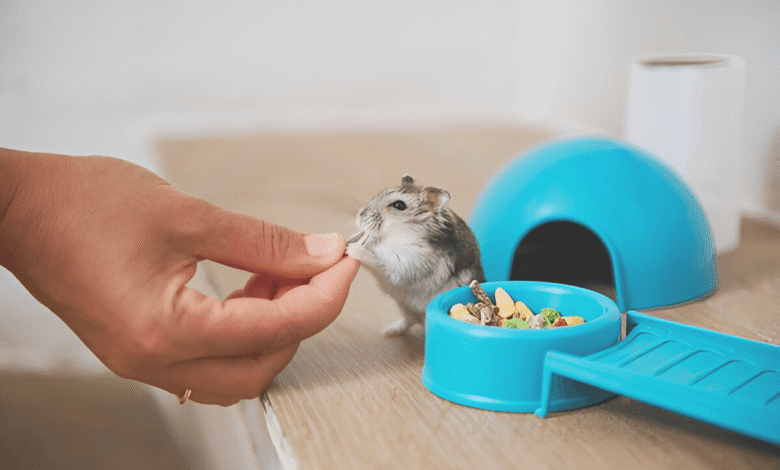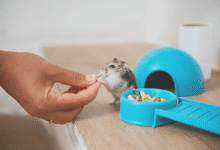
Beginner’s Guide to Caring for Hamsters the Right Way
Caring for Hamsters beginners Learn proper cage setup, diet, handling & health tips to keep your pet happy and thriving. Start right.
Caring for Hamsters may seem simple, but these small pets have specific needs that must be met to ensure they live happy, healthy lives. Many new owners underestimate the importance of proper housing, diet, and enrichment, leading to stressed or unhealthy hamsters. Whether you’re bringing home a Syrian hamster or a dwarf hamster, understanding their unique requirements is essential. This guide will walk you through everything from selecting the right cage to providing mental stimulation, helping you become a confident and responsible hamster owner.
Caring for Hamsters are popular pets due to their compact size and adorable nature, but they require more attention than many people realize. A well-cared-for hamster can live 2-3 years or longer, but poor hamster care can lead to illness and a shortened lifespan. By learning the basics such as the best bedding, safe foods, and handling techniques you can create a thriving environment for your furry friend.
Beginner’s Guide to Caring for Hamsters the Right Way
Choosing the Right Hamster
Before bringing a hamster home, it’s essential to pick the right species. Syrian Caring for Hamsters are larger, solitary, and great for beginners, while dwarf hamsters (like Roborovski or Campbell’s) are smaller and more social but require careful handling. Research their temperaments and lifespans Syrian hamsters live 2-3 years, whereas dwarf hamsters may live slightly shorter lives. Always adopt from reputable breeders or rescue centers to ensure your pet is healthy.
Setting Up the Perfect Hamster Cage
A proper Caring for Hamsters cage is crucial for your pet’s well-being. Avoid small, plastic cages and opt for a spacious wire cage or a glass tank (minimum 450 square inches of floor space). Provide bedding material like aspen shavings or paper-based products avoid cedar or pine, as they can harm your hamster’s respiratory system. Include a hideout, an exercise wheel (solid-surface to prevent injuries), and chew toys to keep their teeth healthy.
Feeding Your Hamster a Balanced Diet
A balanced diet is key to a Caring for Hamsters. Commercial hamster pellets provide essential nutrients, but supplement them with fresh vegetables (carrots, broccoli) and occasional fruits (apples, bananas). Avoid sugary or citrus foods. Protein sources like mealworms or boiled eggs are great for growth. Always provide fresh water in a sipper bottle to prevent spills and contamination. Overfeeding can lead to obesity, so monitor portion sizes.
Maintaining Proper Hygiene
Caring for Hamsters are clean animals but need a little help from their owners. Spot-clean the hamster cage daily by removing soiled bedding. Perform a full clean weekly, but avoid over-cleaning, as it can stress your pet. Use a mild, pet-safe disinfectant. Hamsters groom themselves, so baths are unnecessary instead, provide a sand bath (chinchilla sand) for dwarf hamsters to keep their fur clean.
Ensuring Mental and Physical Stimulation
Caring for Hamsters are active creatures that need mental stimulation and exercise. An exercise wheel is a must, but also include tunnels, climbing structures, and foraging toys. Scatter food around the cage to encourage natural foraging behavior. Hand-taming your hamster slowly builds trust offer treats from your palm and avoid sudden movements.
Monitoring Your Hamster’s Health
A Caring for Hamsters is alert, active, and has a shiny coat. Common health issues include wet tail (a bacterial infection), overgrown teeth, and Respiratory disease. If your hamster shows signs of lethargy, weight loss, or unusual discharge, consult a vet immediately. Regular check-ups can prevent serious illnesses.
Handling and Socializing Your Hamster
Start With Trust-Building
Begin by placing your hand near the cage daily, allowing your hamster to sniff you. Offer treats through the bars to create positive associations before attempting to handle them directly. Progress to open-hand feeding inside the cage.
Proper Handling Techniques
Always scoop your hamster gently with both hands, supporting their entire body. Never grab from above or squeeze. Keep initial sessions brief (2-3 minutes) and return them to their cage at the first sign of stress like squirming or biting.
Socialization Schedule
Handle your hamster at the same time daily, ideally during their active evening hours. Increase duration gradually as they become comfortable. Pair handling with treats and soft talking to reinforce positive experiences and build lasting trust.
Challenges of Beginner’s Guide to Caring for Hamsters
Choosing the Wrong Cage Size
Many beginners underestimate space requirements, leading to stress and health issues. The minimum 450 sq inches rule is often ignored for “cute” but cramped habitats. Bar spacing also poses escape risks for dwarf breeds.
Improper Diet Management
Novices frequently overfeed treats or offer unsafe foods (citrus, onions). Pellet-only diets lack variety, while seed mixes encourage selective eating. Portion control is challenging with tiny stomachs.
Handling Difficulties
Rushing the taming process causes bites or trauma. Owners struggle reading stress signals like freezing or ear positioning. Small children often mishandle fragile hamster bodies.
Health Issue Recognition
Early symptoms (wet tail, overgrown teeth) go unnoticed. Many mistake normal behaviors (night activity) for illness. Finding exotic vets proves difficult in some areas.
Cleaning Routine Balance
Over-cleaning destroys scent markers causing stress, while under-cleaning risks ammonia buildup. Owners battle odor control while maintaining proper bedding depth for burrowing.
Socialization Missteps
Attempting to house incompatible hamsters together leads to fights. Misinterpretation of play vs aggression causes dangerous situations. Solitary Syrians often get mistakenly paired.
Enrichment Shortcomings
Wheels with dangerous rungs or insufficient chew toys are common. Owners struggle providing mental stimulation between work/school schedules. Boredom leads to bar-chewing or depression.
Temperature Sensitivity
Maintaining the ideal 65-75°F range challenges owners in extreme climates. Drafty rooms or direct sunlight exposure create dangerous conditions quickly.
Cost Underestimation
Initial “low maintenance” expectations clash with vet bills, quality food, and proper habitat expenses. Many don’t budget for emergency care needs.
Read More: Understanding Common Household Toxins and Their Effects on Pets
Conclusion
Providing proper Caring for Hamsters is essential to ensuring your small pet lives a long, happy, and healthy life. By following the guidelines in this beginner’s guide from selecting the right habitat to offering a balanced diet and enrichment you’ll create an environment where your hamster can thrive. Remember, these tiny creatures rely entirely on you for their well-being, so consistency and attention to detail make all the difference.
Whether you’re a first-time owner or looking to refine your Caring for Hamsters routine, the key is patience and observation. Every Caring for Hamsters has unique preferences and behaviors, so take the time to understand your pet’s needs. With the right knowledge and commitment, you’ll not only meet their basic requirements but also build a trusting bond that makes pet ownership truly rewarding. Your hamster’s health and happiness are well worth the effort!
FAQs
What’s the ideal cage size for a hamster?
The minimum recommended size is 450 square inches of floor space, with larger enclosures preferred for active breeds like Syrian hamsters.
How often should I feed my hamster?
Provide 1-2 tablespoons of quality hamster mix daily, supplemented with fresh veggies 2-3 times weekly and occasional protein treats.
Can hamsters live together?
Syrian hamsters must live alone, while some dwarf species may cohabitate if introduced properly and monitored closely for aggression.
What type of bedding is safest?
Use unscented paper-based bedding or aspen shavings – avoid cedar or pine which can cause respiratory issues.
How do I tame a scared hamster?
Start by offering treats from your hand, speak softly, and progress to short handling sessions only when your hamster appears comfortable.







